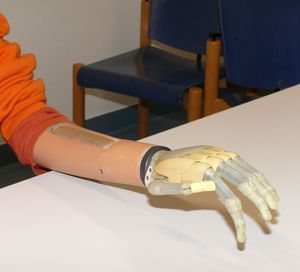Each finger can be moved separately
|
|
A new prosthetic hand is being tested at the Orthopedic University Hospital in Heidelberg / Grip function almost like a natural hand
It can hold a credit card, use a keyboard with the index finger, and lift a bag weighing up to 20 kg – the world’s first commercially available pros-thetic hand that can move each finger separately and has an astounding range of grip configurations. For the first time worldwide a patient at the Orthopedic University Hospital in Heidelberg has tested both the “i-LIMB” hand in comparison with another innovative prosthesis, the so called ”Flu-idhand”. Eighteen-year-old Sören Wolf, who was born with only one hand, is enthusiastic about its capabilities.
The new prosthetic hand developed and distributed by the Scottish com-pany “Touch Bionics” certainly has advantages over previous models. For example, a comparable standard product from another manufacturer al-lows only a pinch grip using thumb, index, and middle finger, and not a grip using all five fingers. This does not allow a full-wrap grip of an object.
Myoelectric signals from the stump of the arm control the prosthesis
Complex electronics and five motors contained in the fingers enable every digit of the i-LIMB to be powered individually. A passive positioning of the thumb enables various grip configurations to be activated. The myoelectric signals from the stump control the prosthetic hand; muscle signals are picked up by electrodes on the skin and transferred to the control electron-ics in the prosthetic hand. Batteries provide the necessary power.
The “Fluidhand” from Karlsruhe, thus far developed only as a prototype that is also being tested in the Orthopedic University Hospital in Heidel-berg, is based on a somewhat different principle. Unlike its predecessors, the new hand can close around objects, even those with irregular surfaces. A large contact surface and soft, passive form elements greatly reduce the gripping power required to hold onto such an object. The hand also feels softer, more elastic, and more natural than conventional hard prosthetic devices.
“Fluidhand” prosthetic device offers better finishing and better grip function
The flexible drives are located directly in the movable finger joints and operate on the biological principle of the spider leg – to flex the joints, elastic chambers are pumped up by miniature hydraulics. In this way, in-dex finger, middle finger and thumb can be moved independently. The prosthetic hand gives the stump feedback, enabling the amputee to sense the strength of the grip.
 Thus far, So"ren has been the only patient in Heidelberg who has tested both models. “This experience is very important for us,” says Simon Steffen, Director of the Department of Upper Extremities at the Orthopedic University Hospital in Heidelberg. The two new models were the best of those tested, with a slight advantage for Fluidhand because of its better finishing, the programmed grip configurations, power feedback, and the more easily adjustable controls. However, this prosthetic device is not in serial production. “First the developers have to find a company to produce it,” says Alfons Fuchs, Director of Orthopedics Engineering at the Orthope-dic University Hospital in Heidelberg, as the costs of manufacturing it are comparatively high. However it is possible to produce an individual model. Thus far, only one patient in the world has received a Fluidhand for every-day use. A second patient will soon be fitted with this innovative prosthe-sis in Heidelberg.
Thus far, So"ren has been the only patient in Heidelberg who has tested both models. “This experience is very important for us,” says Simon Steffen, Director of the Department of Upper Extremities at the Orthopedic University Hospital in Heidelberg. The two new models were the best of those tested, with a slight advantage for Fluidhand because of its better finishing, the programmed grip configurations, power feedback, and the more easily adjustable controls. However, this prosthetic device is not in serial production. “First the developers have to find a company to produce it,” says Alfons Fuchs, Director of Orthopedics Engineering at the Orthope-dic University Hospital in Heidelberg, as the costs of manufacturing it are comparatively high. However it is possible to produce an individual model. Thus far, only one patient in the world has received a Fluidhand for every-day use. A second patient will soon be fitted with this innovative prosthe-sis in Heidelberg.
Heidelberg Orthopedic Workshop provide a unique service in Germany
The workshop at the Orthopedic University Hospital in Heidelberg has been in existence since 1919 and is unique in Germany. Since the Tha-lidomide tragedy in the 1960s it has had its own research department. Today there are some 60 specialized professionals employed in the ortho-pedic workshop who have learned their trade in many years of training. Every year, around 5,000 patients are fitted with orthopedic aids.
Contact:
Alfons Fuchs
Director of Technical Orthopedics
Stiftung Orthopa"dische Universita"tsklinik
Schlierbacher Landstrasse 200
69118 Heidelberg
Germany
Phone: +49 6221 / 96 6406
Email: .(JavaScript must be enabled to view this email address)
Print Version
Tell-a-Friend comments powered by Disqus





